We may receive a commission when you use our affiliate links. However, this does not impact our recommendations.
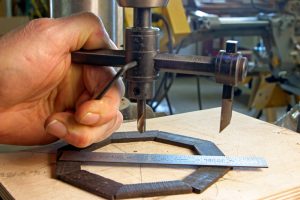 Perhaps the headline should read “the tool I hate to love.” Every now and then I need something round, or an odd-sized hole, and I turn to the “adjustable circle cutter.” I know it as a “fly cutter” and it is never my first choice. It’s a simple device, but it looks scary, and for good reasons. It can do some serious damage if you don’t follow the rules for using one safely. Here are my rules:
Perhaps the headline should read “the tool I hate to love.” Every now and then I need something round, or an odd-sized hole, and I turn to the “adjustable circle cutter.” I know it as a “fly cutter” and it is never my first choice. It’s a simple device, but it looks scary, and for good reasons. It can do some serious damage if you don’t follow the rules for using one safely. Here are my rules:
 Sharpen the cutter – these come with a decent grind on them, but a few strokes on the sharpening stones give a cleaner cut with less resistance.
Sharpen the cutter – these come with a decent grind on them, but a few strokes on the sharpening stones give a cleaner cut with less resistance.- Make sure that all of the Allen screws are really, really tight – one of the nice things about this tool is that everything is adjustable; the radius of the knife and the depth of both the drill bit and the knife can be set.
- Double-check that all of the Allen screws are really, really tight – one of the bad things about this tool is that everything is adjustable. If one of those screws comes loose while the tool spinning around, things can go flying. Hence the term “fly cutter.”
- Run the drill press at the slowest possible speed. On our Powermatic that’s around 400 RPM, and I wish this machine could be set down around 250 RPM. I would feel better if it did.
- Clamp the work securely to the drill press table and don’t get your hands anywhere near the thing when it’s running. If something goes wrong, turn off the machine and duck under the table until the spinning stops.
- Feed the cutter into the work as slowly and gently as you can.
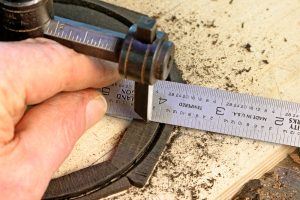 In spite of the threatening nature of this tool, you can make precise, clean cuts with it when other tools let you down. I needed a band of ebony, about 1/8″ thick and 1/8″ wide to stick in a 4-1/4″-diameter slot. I wanted to use as little material as possible so I had six pieces mitered together and stuck down to a scrap of plywood.
In spite of the threatening nature of this tool, you can make precise, clean cuts with it when other tools let you down. I needed a band of ebony, about 1/8″ thick and 1/8″ wide to stick in a 4-1/4″-diameter slot. I wanted to use as little material as possible so I had six pieces mitered together and stuck down to a scrap of plywood.
My first thought was to use the same router that I used to make the slot, and different-sized guide collars with the same pattern I used to rout the slot. Attempt number one failed almost immediately when the pieces started coming off the substrate. Attempt number two failed very close to the end of the procedure. Making the final pass, the thin strips lifted off the bed and disappeared into thin air. A router bit generates a lot of force on a strip that thin, and there isn’t enough surface area for a removable adhesive to hold.
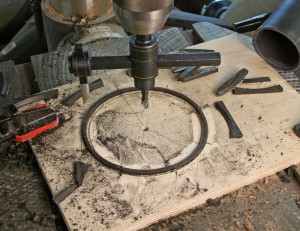 I thought of using the lathe for “Plan B,” but I wanted a way to precisely set the diameters I needed. As I formulated a scheme for mounting the bank to the headstock and marking and making the cuts, I remembered the fly futter stuck in a drawer somewhere. On to “Plan C.”
I thought of using the lathe for “Plan B,” but I wanted a way to precisely set the diameters I needed. As I formulated a scheme for mounting the bank to the headstock and marking and making the cuts, I remembered the fly futter stuck in a drawer somewhere. On to “Plan C.”
The cutter is reversible, so you can set it for either a clean inside or outside cut. I cut the outside, then reversed the cutter and adjusted its position on the bar. Because the cutter comes to a sharp point, it can be set quite accurately. I was happy with the results, and regretted the hour or two I wasted trying to get the router to work.
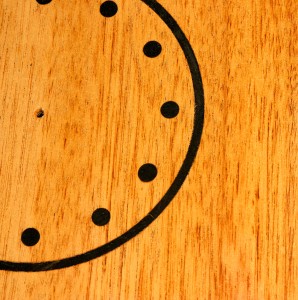 At this point, you may be wondering why on earth someone would need an 1/8″-wide circular strip of ebony. The picture at left, of the ebony glued in place and trimmed flush is a clue – but you’ll need to read an “upcoming issue” of Popular Woodworking Magazine to get the whole story. If you’re a subscriber, don’t worry. If your not a subscriber, you can fix that by clicking on this link.
At this point, you may be wondering why on earth someone would need an 1/8″-wide circular strip of ebony. The picture at left, of the ebony glued in place and trimmed flush is a clue – but you’ll need to read an “upcoming issue” of Popular Woodworking Magazine to get the whole story. If you’re a subscriber, don’t worry. If your not a subscriber, you can fix that by clicking on this link.
Here are some supplies and tools we find essential in our everyday work around the shop. We may receive a commission from sales referred by our links; however, we have carefully selected these products for their usefulness and quality.



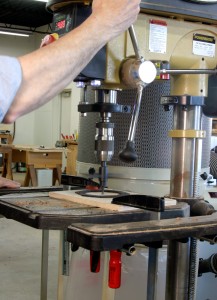




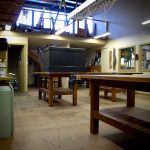

Yeah, the tool seems scary. But, after cutting more than twenty 12cm holes I feel very confident with it. The best part: since my drill press does not reach the distance I needed, I had to use my HAND power drill (as the back instructions present in the tool blister suggests!).
At first I was a bit afraid but got the hang of it. You just have to put another sheet of wood below the one to be cut, step on the part (as the instructions also say), drill a guide hole before and then start the power drill, slowly going into the wood. At some point, just flip the thing over and continue cutting from the other side. Works fine and the hole comes out a LOT better than with a router! Yes, I also tried the router…not good. Cheers.
It is definitely a scary tool. Suggest you paint the extremes of the rotating parts in a bright fluorescent colour, so you can see the area of danger
Few additional caveats:
The other thing that should be mentioned twice is that be sure the drill is set to the slowest setting. Sometimes the drill must be on to reduce the speed – do this before attaching the cutter! I turning the drill on at the higher speed once and I was lucky; if the blade had not been tightened ….
Also the edge of the circle can be beveled or not beveled depending on the orientation of the cutter and if you want to keep the circle or keep the hole.
Fly little cutter, fly away!
I’ve used these before, a palpable level of fear is a natural reaction. Having an arm the extends out like that is scary, as is the overall generally cheap construction that means your depending on some tiny set screws to stay in place.
There are industrial versions of this tool, including ones with a geared mechanism and two cutters, but they are quite pricy as you would expect.
I’m surprised that a router approach wouldn’t work better — using a small spiral cut bit and a compass assembly to swing the router in an arc (or a full circle).
I like to to mount a transparent shield on the drill press table when using a circle cutter like this. In part if keeps chips from flying in my face as I make the cut. It also makes it difficult to put my hands (or nose) in the way of the cutter.
I use a flat polycarbonate sheet mounted in a little frame that attaches to T-track near the front of my drill press table. The edges of the screen are marked in red. Besides being a barrier, the shield reminds me that this is not the ordinary setup of the press that I am used to with the usual compact cylindrical bit in the chuck.
Even at the lowest speed, the cutter moves alarmingly fast and cuts an arc much wider than any ordinary drill bit. My press goes down to 150 RPM or 2½ RPS, but even at this slow speed, the movement of the cutter is just a blur, hard to focus on and easy to forget. I like to put a physical barrier between the cutter and me.
I was never fussy about using the fly cutter, but found ok on smaller diameters,
like under 2 1/2 inches.
But I also need small circular arcs, so I made a small circle cutting base
for my router – which covers 2 to 6 inch diameter, and can do semi circles.
Loved your writing, Bob. Especially the “duck under the table” part. I still have the scars from a knuckle-busting experience so I’m using a drywaller’s overhead circle cutting rig. It has a protective shroud to catch the dust and in my case it’s also pinky saver.
I don’t know a lot about fly cutters, other than I really like sloughin’s safety idea.
I am, however really anxious to read about the clock. What issue will it be in?
Had to laugh. My OTHER passion is treadle sewing machines, so I immediately went to rotary cutters for fabric and was REALLY curious to figure out what new use I had for mine.
http://www.joann.com/images/00/66/2/xprd6627_m.jpg
RileyG
I like Moontoad’s suggestion about the neon paint! Another thing that I do — call me paranoid if you like — is to clamp a special jig to my drill press table that consists of a piece of 3/4″ MDF about the same size as the table, with a 6 inch high board glued and screwed to the edge closest to my belly. This way, if the cutter does fly off, it doesn’t embed itself in my gut. I also wear the full face shield that I use for lathe work, rather than my smaller safety glasses.
I’ve used mine a number of times…and it always scares me to death. But it works.
Just stay back about three feet.
You can get stringing to fit a curve by heating it on a hot iron pipe. You wouldn’t be as elegant as the method you chosen because it would have taken multiple pieces. I never have done it with ebony and it may be too brittle to take the curve. How do they do it on guitars?
A question and a suggestion:
1. What did you use to glue the pieces to the substrate?
2. I use my fly cutter occasionally, and it always makes me nervous. One simple tip I tried that helps a little is to paint the ends of the horizontal shaft with a bright-colored paint (I used neon fingernail polish.) This makes it easy to see the circumference traced by the shaft when it is spinning. This is especially important when cutting smaller radii and the shaft projects significantly beyond the bit location.
What about using the lathe and the Circle Cutter together? If you have a drill chuck for your lathe, you could chuck the Circle Cutter in the lathe. The Circle Cutter could be stationary and the wood could spin. You could have the best of both worlds, without having the circle cutter spinning around!
Mike
I tried one of these a long time ago…and it caused the chuck to fall off my drill press.